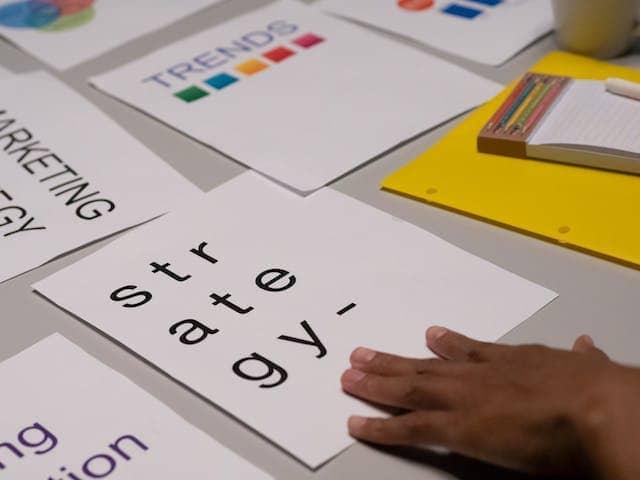What Is a Futurist? How to Create a Business Forecast

If you want to succeed in your business, you’ll need to do more than simply respond to existing trends. You’ll also need to figure out future developments today. Business planning for the future isn’t optional if you want your business to succeed. In fact, it’s imperative to strive for a proactive mindset and plan for the future.
As the old saying goes, “Failing to plan is planning to fail.” That may not be literally true in every case. However, as a general rule, long-range planning helps keep your company’s operations on track.
For example, predictive marketing can help you more readily convert prospects to customers by meeting those buyers where they’re going to be in the future. Predictive SEO planning helps content marketers boost their content creation efforts and generate more leads as well.
Yet, planning also takes a toll, no matter what the context. How are you supposed to know what future conditions may develop to alter the landscape and your carefully drawn plans?
That’s where the futurist’s capacity to forecast comes in, and fortunately, it’s a skill anyone can develop.
What is a futurist?
A futurist is a kind of social scientist who advises brands about the potential shape of the future. This may include trends, likely opportunities, and changes coming down the pike. The purpose is to help companies prepare to take advantage of the potential opportunities and avoid possible threats.
There’s no superpower or psychic ability involved. Instead, forecasts are based on specific, drilled-down research and data to illuminate what’s coming. It could be technological developments, for example, or environmental or legal shifts that can impact business plans — or disrupt them entirely.
Futurists aren’t psychics. They don’t simply predict the future. Rather, they try to sketch out a variety of likely outcomes and developments, while also acknowledging the possible outlier events that can throw a curveball into your path and disrupt the most thorough preparations.
Futurists can work for themselves as freelancers or owners of their own consultancies, or they can work for governmental bodies, businesses, nonprofits or think tanks. They’re skilled at recognizing and identifying trends, as well as explaining the forces and contours of those trends and how they might affect business in general, specific industries, and life in general.
What is forecasting?
How do futurists actually create their forecasts? The essence of the process synthesizes historical data to create informed estimates about future trends. Yet, that’s a broad description that encompasses some complex details.
Another part of forecasting involves seeing possibilities and identifying trends as they begin to emerge, instead of after they’ve been established. That’s relatively simple when there’s a lot of base data on which to formulate a forecast but can get more complex when there are multiple unknown factors and a dearth of historical data.
For example, futurists use a method known as scenario analysis to make an educated guess as to the future value of a portfolio, item or process over time, given certain assumed developments (i.e., a change in the global business environment, evolving market trends, rising interest rates, etc.). It’s based heavily on the futurist’s assumed factors and determinative elements and may rely on a computer simulation component. It can evaluate both the expected and the unlikely or “worst-case” conditions.
Forecast models for your business
Futurists use many different types of forecasting models, ranging in complexity that are best suited to various types of situations. There are four major types of models that are used for forecasting in different business contexts, including sales, product development, consumer behavior and more.
- Time series model: This model uses historical data to visualize patterns in that data over a specific period of time (hours, weeks, years, depending on the specific question and context)
- Econometric model: This type of model is most often used by economists to forecast future developments in economic conditions such as costs, prices, or supply and demand, integrating complex financial and socioeconomic data to project future changes.
- Judgmental forecasting model: When there is insufficient (or no) objective data available on which to base a forecast, futurists use this model type to craft intuitive and subjective views of future developments. The resulting forecast will be inherently more limited than those based on massive amounts of data, but it will be more flexible; when you can add more information, the forecast becomes more detailed and accurate, and less subjective.
- The Delphi method: Named after the famous Oracle of Delphi of the ancient world, this method utilizes the consultative services of a group of experts, working together to create a forecast around a designated topic. The group takes turns answering a series of increasingly specific questions and (hopefully) reaching consensus on each round before proceeding to the next until a full picture of anticipated future developments emerges.
Learn to think like a futurist
Forecasting for your business the way a futurist would is a skill almost anyone can learn and develop. After all, the foundation of successful forecasting is simply knowing which questions to ask and keeping an open enough mind to anticipate a wide range of possibilities.
You can learn to make unexpected connections between data or statistics and subject matter expertise, using creative leaps to connect them to your conclusions about the future — no crystal ball required.
This is exactly what futurists do, but it’s also what everyday brands do regularly in order to figure out future moves and decisions. The goal is to focus on foresight that might lead to insights that can fuel future — and hopefully profitable — actions.
1. Nail the mindset
It’s broad, multidisciplinary, and nonlinear. It is micro, as it looks at very specific developments, and macro, as it puts the micro into the context of more global situations.
But it’s not magic or crystal ball gazing. It’s simply a more concentrated form of long-term thinking. No business can be successful without some level of this.
2. Explore the possibilities
One of the biggest challenges for those new to forecasting is the tendency to close off to possibilities that lie at the fringe of personal experience or beyond. To be fair, it’s hard to consider the probabilities behind an event that you’ve never personally witnessed or lived through; we all tend to expect the expected.
Yet the ability to open up to all the various options for an outcome is crucial to forecasting. It isn’t about making concrete, fixed predictions but rather about evaluating possibilities based on existing data. To combat this tendency to focus on the known quantities, don’t shut down ideation or brainstorming too soon. Consider past experience, but also get in the habit of asking questions like “What if ….?” and “What next….?”
3. Look for new signals
What’s evolving or beginning? Not just in your field but in tangentially related industries and even in unconnected contexts. You never know what might impact your business or field. Anything might serve as that hypothetical butterfly a continent away, flapping its wings and causing a hurricane for your company.
4. Evaluate online and print resources and tools
Explore available futurism resources and begin to create your own library of reference materials. To get started, try these sites and organizations:
- Good Judgment Open resources
- Futurist Jack Uldrich’s curated articles library
- Ross Dawson’s collection of resources for the future of specific industries and sectors
- The World Future Studies Federation
- The Association of Professional Futurists
5. Create an input system for signals
The building blocks of forecasting are signals — events, occurrences and pieces of information that might offer an indication of emerging trends or developments. The key to successful forecasting is the ability to collect, curate and synthesize signals from many different types of sources.
To create your signal-input system, one of the simplest ways to begin is by collecting email newsletters. These are often staffed by subject-matter experts (SMEs) and highly experienced journalists.
Remember that scene from ‘Working Girl’ where Melanie Griffith explains to the potential business partners exactly how she came up with her profitable idea?
The key to her success in that moment was twofold:
- She fostered a habit of reading widely from many disparate sources.
- She saved that information so she could later put seemingly unrelated ideas together in a creative way.
Go beyond newsletters in your field or industry to subscribe to a variety of different general news, business, and finance newsletters as well. Be judicious in selecting your resources, since each will necessarily take up bandwidth in your busy day.
A few to try include:
Begin each morning by scanning your selected newsletters and making note of potential signals.
6. Re-examine historical data in a new light
Another key skill in business forecasting is the ability to examine historical data in a new way. By looking for patterns and examining real-time data versus historical data, you hone your ability to identify potential inflection points, both past and present.
Take a close look through your company’s accumulated data and any historical statistics you can access on your industry, niche, geographical market or other relevant segments. Try mentally plotting that historical data against known events or occurrences. This helps you pinpoint bellwether events and signals that you can keep an eye out for in the present to forecast the future.
7. Assemble your own council of experts
Just like the Delphi model suggests, relying on a group of well-informed, focused experts can lead to superior ideation and creativity. Go beyond your own field, however. Curate an engaged community of other colleagues, freelancers, and entrepreneurs that can help you keep abreast of other perspectives and new developments in other fields. An educated, diverse, and engaged crowd of smart people is one of the most valuable business assets you can have.
Broaden your horizons
Adopting a futurist’s approach can help you craft more reliable, useful forecasts and inform more successful future plans for your company. Forecasting does take you out of the typical busy business owner’s mindset, with its day-in and day-out focus on the here and now.
By embracing the broader, creative perspective of the futurist, you can help spot those valuable opportunities and threatening pitfalls before they take you by surprise.
Thanks for reading! Do you want to create thought leadership articles like the one above? If you struggle to translate your ideas into content that will help build credibility and influence others, sign up to get John’s latest online course “Writing From Your Voice” here.



